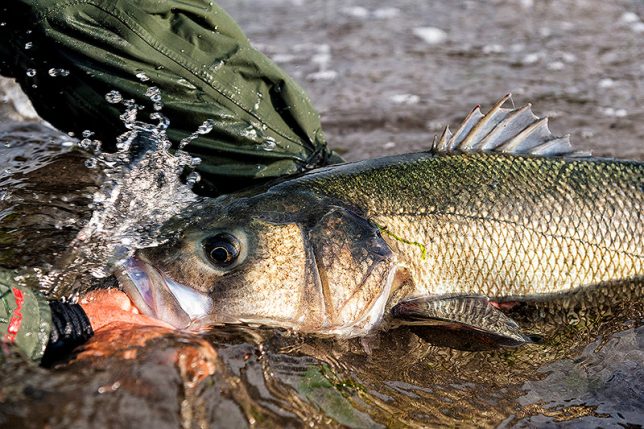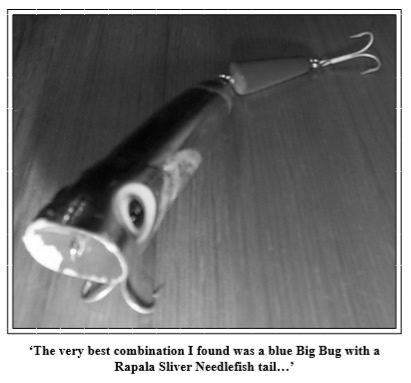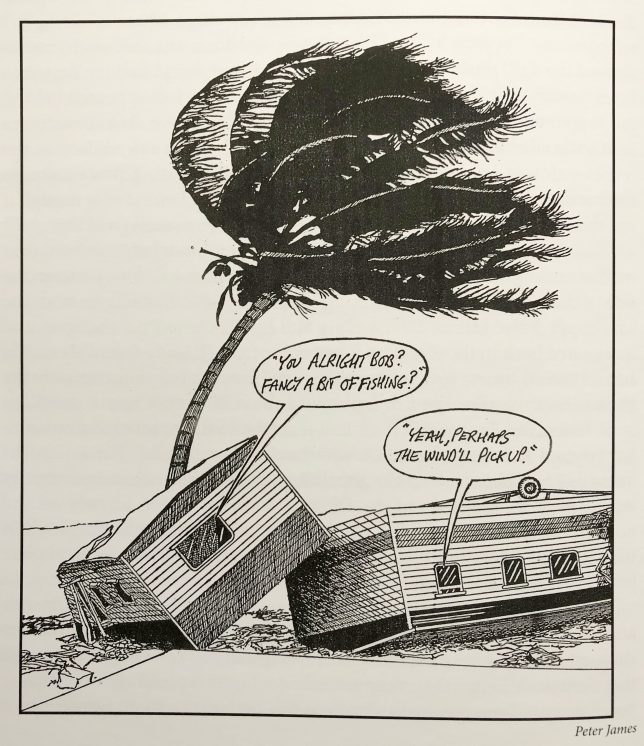CHAPTER 3 – TECHNIQUES – LURE FISHING
The Shy Followers
Ever had a bass follow your popper and not take it? What did you do next – cast straight back out to where you last saw the fish perhaps? Maybe change your popper for another model, slightly smaller or slightly larger or the one with the tassel still attached to the tail treble? Or did you just stand and stare like a scolded child, cursing your misfortune and blaming it on everything and everyone, including the fish and the weather and the pair trawler skippers and anyone else you can think of?
Most of us would simply have another cast with the same lure, hoping that this time the fish will be more interested in the offering especially if you adopt a slightly different style of retrieve. And sometimes this works . . . but often it doesn’t. I’m not talking about those fish that make a genuine effort to nail the lure but for whatever reason fail to do so, I’m talking about those cautious fish that follow the tail of the plug just below the surface, often for many yards without being tempted to grab hold of it.

Fishing from a boat or from an elevated position on the rocks gives you the chance to see things differently than you would otherwise be able to, say compared to fishing in the surf. Most of us have seen fish follow a lure in the manner described, but have you ever wondered how many more fish might be following and refusing your offering as you put cast after cast into the water? I have, especially when the takes are infrequent but I know (or strongly suspect) that fish are present. Sometimes, when the water and light conditions are just right, you get a real insight into what is happening below the surface . . . and it can be quite shocking to see how often fish investigate and then refuse your lure.
Let’s think about the design of the lure. I agree with Steve Butler’s comments in another article that, once the sun comes out, a lure with some flash in it will normally outscore one without. Even then you can suffer the dreaded shy follower experience. Some say that flash is better in low light, particularly with shallow diving lures, but who’s to say anyone’s right or wrong on this – isn’t this uncertainty part of the overall joy of fishing? Why fish refuse to take the lure is a subject all of its own and I’m not going to speculate why this might happen, but there are a couple of ways you can connect with these followers if you actually know they are coming up short.
One way is to attach a hair rig behind the tail treble on a popper and attach a saltwater streamer fly anything up to three feet behind the lure. It’s something that is used to great effect when fishing for striped bass. You can even attach it above and in front of the popper if you want to; it still works, but both techniques may affect the enjoyment you get out of casting a single lure attached directly to your line. If you start getting tangles you should vary the length of the hair rig until you find what works best – when I tried this I found that different line types, breaking strains and lengths greatly affected the aerodynamics and it is really a case of trial and error. The strength and direction of the wind obviously has an effect as well, so all in all it can be a little difficult to adopt this method if you need to quickly react when a shy fish appears. This is assuming you don’t chose to fish this way all the time, of course.
If you are using a fly in this way I suggest you flatten the barb on it before you start flinging it around . . . it can be very difficult to predict the whereabouts of the light fly as it swings below the heavier lure when you prepare to cast, and the chances of serious injury are too high for you to ignore this warning! I once embedded the fly hook beyond the barb in a length of anchor rope lying over the stern of my boat and it was only the light drag setting on my reel that prevented me from smashing my rod to pieces – be warned! Your eyes are trained to watch the plug and you will, at some point, forget the fly.
Also, not surprisingly, the fly won’t fish as well being dragged along behind a popper as it would if you fished the fly on its own, but don’t forget I’m suggesting you consider using this method to pick up followers that are otherwise refusing your lure. If you experiment and concentrate on fishing the fly most effectively, and sacrifice some of the action you would normally impart on the lure, then this might well help. You might also consider fishing a tiny Redgill behind the plug, or even threading it onto your mainline a yard or two up line of it . . . all these will work on their day.
Another, far more effective way I have found is to use a tail directly on the popper itself. Before I explain how, let’s look at one of the most popular poppers used at the moment by B.A.S.S. members. Like most popper fanatics I love using Storm Saltwater Big Bugs, and it doesn’t matter to me what colour they are, or how battered they look, they nearly always catch if you impart the right action into them. They are big and heavy, have a nice finish (when new), with lots of chrome and a nice sparkly tassel on the tail hook, and they cast really well.
The one failing of this lure, in my opinion, is that its tail action is non-existent – all of the action is at the front end. If fished correctly it displaces lots of water and it attracts fish from a considerable distance, enticing them enough to attack the lure more often than they will refuse it, usually. But its rear section, the ‘tail’ is a real disappointment, and I think this is the reason why the lure often attracts the shy follower.
I experimented with different tails attached to the rear split ring on the Big Bug. I caught bass on an amazing variety of tail ends attached this way, including twin tails, half a Redgill, jelly worms, the back half of various Rapalas and several other ready-made or easily adapted offerings. The Big Bug attracted the fish in the first place and the action of the tail suckered them into grabbing it. Virtually every fish I caught was hooked on the tail of the popper, regardless of what tail was used and despite me using single hooks more often than trebles.
 The very best combination I found was a blue Big Bug with a Rapala Sliver Needlefish tail section. This combination works incredibly well and I now fish the Big Bug exclusively with this new tail. The aerodynamics of the lure are not adversely effected so casting is still great, and the tail section is slightly heavier than you might imagine which makes the tail hang enticingly below the waterline during a slow retrieve. By including a tail in this way you also create a jointed lure with a lovely action, which means you benefit from the added attraction this presents to the bass.
The very best combination I found was a blue Big Bug with a Rapala Sliver Needlefish tail section. This combination works incredibly well and I now fish the Big Bug exclusively with this new tail. The aerodynamics of the lure are not adversely effected so casting is still great, and the tail section is slightly heavier than you might imagine which makes the tail hang enticingly below the waterline during a slow retrieve. By including a tail in this way you also create a jointed lure with a lovely action, which means you benefit from the added attraction this presents to the bass.
The next time you have a shy follower, don’t cast the same lure back out at it in the hope that you might fool it if you do the same thing that failed last time. Clip on a small tail to your popper and try a slower retrieve and I’ll bet you have more hook-ups.
Since making my own two—piece poppers I have found there are a few commercially available options such as the Humpback Mule and the Creek Chub Knucklehead plug. The Knucklehead is a huge lure jointed at the head rather than the tail, but it also has a flash of feathers on its tail – its action is anything but subtle, great for fishing across the top of cresting waves in a tide rip. It also casts slightly better than the Big Bug.
A number of other one-piece popper type lures have tail sections that are shaped so that they drag low in the water during the retrieve, such as the Yo-Zuri or Duel Sliders – these are fantastic subtle lures, and they have accounted for most of my early 2003 fish. They have a sinuous, mesmerising action when retrieved correctly.
So if tails on poppers work so well, why go any further? Well, on really calm days when the sun is shining and the water is oily calm, and the only thing moving is your brain, you start to think about the other possible causes for a bass refusing to hit your lure, even one with a tail on it. I refuse to give up on the idea that the most enjoyable way of fishing for bass is to use a surface popper, and I want to be able to catch them using this method no matter what the weather, the water condition, or the state of the tide. The only time I want to not be able to catch bass on poppers is when there are no bass there. I’ll happily fish with bait, flies and shallow diving lures when the fancy takes me, but I do love the poppers.
Scent
I’ve yet to come across a popper that smells good enough to eat, and I suspect there isn’t a bass, past or present, that would disagree with me. The whole point in using poppers is to attract the fish through their action and through the displacement of water they create. There is a huge visual attraction as well, as the bass homes in on the flashes and movements of the lure as it skitters and pops across the surface, but what about the attraction of how it smells?
You can get various concoctions into which you could dip your favourite plug, some of them are available commercially and some you can make yourself. I decided that if I could produce a tail of my own design that not only improved my hook up rate with poppers through the improved action, and because I could also fish different types of water with it, but also because of the further attraction that a scented tail would bring, then I was onto a winner.
It took me a couple of months to achieve a workable solution and the end result was something to behold. I managed to produce tails made out of wax that I had impregnated with a homemade fish—based concoction that I affectionately called Jungle Juice. It should have been called Cat Appeal because it stinks so bad that every cat in the neighborhood found its way into my kitchen during the period infamously known by my family as ‘The Nights of the Big Brew’.
 The tails are coloured either blue, red, or a combination of the two, and although I made several different sizes the most effective ones proved to be only slightly bigger than the Sliver tail, but they are heavier. Because the scented attractant is laced throughout the wax, my belief is that it retains enough strength to work as long as the tail survives, certainly more so than if it was only applied to the outer surface. Having said that, I can conveniently dip the tails into a thermos flask containing hot water and some Jungle Juice, which has the effect of repairing the appearance and finishing off the tail whilst coating the outer surface with an extra oil deposit of fishy attractant. The flask is fit for no other purpose once you do this! I’ve landed five small bass, (the ones that go crazy when you are trying to grab hold of them on the deck of the boat), on a single tail before it has disintegrated.
The tails are coloured either blue, red, or a combination of the two, and although I made several different sizes the most effective ones proved to be only slightly bigger than the Sliver tail, but they are heavier. Because the scented attractant is laced throughout the wax, my belief is that it retains enough strength to work as long as the tail survives, certainly more so than if it was only applied to the outer surface. Having said that, I can conveniently dip the tails into a thermos flask containing hot water and some Jungle Juice, which has the effect of repairing the appearance and finishing off the tail whilst coating the outer surface with an extra oil deposit of fishy attractant. The flask is fit for no other purpose once you do this! I’ve landed five small bass, (the ones that go crazy when you are trying to grab hold of them on the deck of the boat), on a single tail before it has disintegrated.
Making these things was far more difficult than I first imagined and it cost me a small fortune and a lot of missed fishing time to get to the stage I have, but the end result has been worth it. After catching a few fish on various poppers one calm evening, it went very quiet and the fish seemed to have disappeared. Just as I was about to call it quits I had a fish, a good distance from the boat, momentarily follow my plug without it hitting it. I swapped my Big Bug for one having a scented tail attached and I recast beyond the fish, retrieving the lure slightly slower than I had the first time I had passed over the fish. To my utter surprise, the fish appeared behind the popper and followed it for virtually the whole retrieve, its nose no more than inches behind the lure. As it got closer to the boat I slowed down the retrieve almost to a standstill, with the popper creating practically no surface disturbance at all, and yet the bass just hung behind it as though it was thinking, “Look at you my little beauty, don’t you smell good tonight?”.
OK, so I’m probably getting a little carried away, but what happened next was not make-believe. When the popper was less than a rod length from the side of the boat and I was beginning to wonder what I would do next, the bass nipped the tail and on feeling the hook, turned on the spot and accelerated back in the direction it had come from. It was a fish of about 8lb, a fish I would dearly love to be able to say I landed, but unfortunately the hook came free after the fish had taken about 30 feet of line. I guess the hook had turned as the fish itself had turned and the point probably never got beyond the small barb. Despite having lost the fish I was jubilant because I had clearly seen the fish follow the popper tail and eventually succumb to its scented charm. I’d caught plenty of fish already on the poppers with tails but this fish had been the only one that had behaved in what seemed a totally uncharacteristic manner when other fish had gone totally off the feed.
I’ve sent a few of these scented tails out to a few B.A.S.S. member friends and hopefully we’ll see what they make of them during a whole season. The danger in creating your own fanciful lures is that you can convince yourself that they work better than they actually do, but this could also be because you fish with them more often or even fish better with them because your belief in their effectiveness is biased. Time will tell with my little smelly tails . . . they are in the hands of people who catch bass regularly anyway, so their opinions will be interesting.
Who knows? Apart from anything else, I think it’s fun to try new things when you are fishing. It’s very easy to become complacent and fall into a rut . . . especially if it’s a good one that has a few of fish in it! If you are fortunate enough to have access to marks that produce fish and you catch regularly using the same old techniques, keep yourself stimulated and interested by thinking up new challenges for yourself.
Author: Allan Hughes
Historical note: This article was published in BASS magazine no.107 Winter 2003
© Bass Anglers’ Sportfishing Society 2008